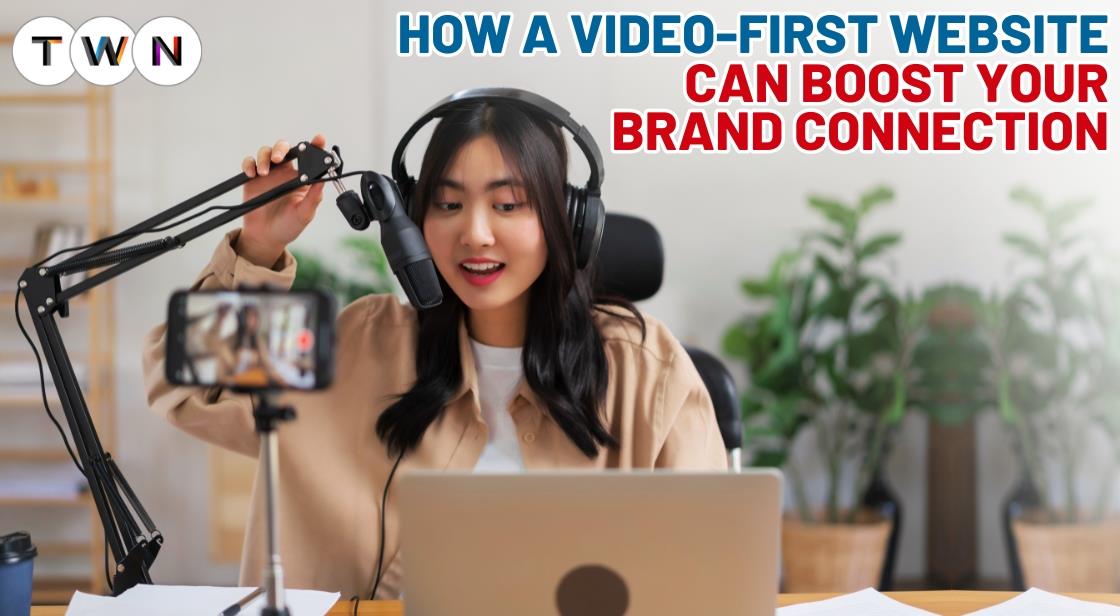How a Video-First Website Can Boost Your Brand Connection

Blog Post
In today’s digital landscape, where first impressions are everything, businesses need to ensure that their websites not only capture attention but also engage visitors on a deeper level. One of the most effective ways to achieve this is by adopting a video-first website approach.
With the rise of video consumption across various platforms, integrating video as the core medium on your website offers an immersive, dynamic experience that static text and images cannot match. Videos have the power to convey emotions, tell stories, and deliver complex messages quickly, making them a key tool for enhancing brand connection and driving customer engagement.
In this blog, we’ll explore how building a video-centric website can help strengthen your brand’s online presence, boost conversions, and foster long-term customer loyalty. Through real-world case studies and best practices, we’ll show how leading brands successfully leverage video to create compelling, memorable experiences for their audience.
Building a Video-Centric Website to Enhance Your Brand Engagement
In today’s digital age, a strong online presence is crucial for businesses to thrive and build a recognizable brand identity. The internet is where customers first encounter a brand, making it essential for companies to create a positive and lasting impression. A well-designed website serves as the cornerstone of this presence, offering an opportunity to communicate the brand’s values, personality, and message to a global audience.
The Rise of Video Content in Web Design and Brand Strategy
Video content has become an integral part of modern web design and brand strategy. It has the unique ability to convey complex messages quickly and engagingly, offering a dynamic experience that static images or text alone cannot achieve. As consumers increasingly consume content on video-centric platforms like YouTube, TikTok, and Instagram, businesses are leveraging video to capture attention, evoke emotions, and reinforce brand messaging. Video marketing has proven to be one of the most effective tools for building brand loyalty and increasing conversion rates.
1. The Power of Video in Modern Marketing
The Rise of Video as a Preferred Content Format
In recent years, video has emerged as the dominant content format across various platforms, such as YouTube, TikTok, Instagram, and Facebook. The widespread accessibility of smartphones and high-speed internet has fueled the growth of video consumption, with platforms like TikTok and YouTube becoming central to daily online experiences. People now prefer video because it is engaging, dynamic, and offers richer content compared to static images or text.
Impact of Video on Consumer Engagement, Brand Recall, and Conversion Rates
Studies and statistics consistently show the powerful impact of video on consumer behavior:
-
According to Wyzowl's 2023 Video Marketing Statistics, 86% of businesses use video as a marketing tool, with 93% of marketers saying it has helped increase user understanding of their product or service.
-
HubSpot found that 54% of consumers want to see more video content from brands they support, emphasizing video’s role in driving engagement.
-
Vidooly research shows that video content generates 1200% more shares than text and images combined, contributing to higher brand recall.
Why Video Resonates More Than Static Images or Text
Videos combine visual, auditory, and emotional elements, creating a more immersive experience than static images or text alone. The ability to convey motion, sound, and expression allows brands to tell more engaging stories and evoke stronger emotional connections.
Whether it’s through storytelling, product demos, or behind-the-scenes content, video allows consumers to connect on a deeper level with a brand, which leads to better retention and increased trust.
Also Read: The Best Advertising Techniques to Succeed in 2025
2. Why Choose a Video-First Website Approach?
What is a Video-First Website?
A video-first website prioritizes video content as the main medium for communication, engagement, and branding. Unlike traditional websites, which often rely heavily on text and static images, a video-first website uses videos as its core element to convey messages, showcase products, and tell stories. This approach leverages videos to immediately capture attention and provide visitors with a dynamic, immersive experience.
Difference from Traditional Text-Heavy Websites
Traditional websites are often text-heavy, with a focus on written content to convey key information. While informative, these sites can sometimes lack emotional appeal or fail to engage users beyond reading. In contrast, a video-first website integrates video as the central feature, reducing the reliance on long blocks of text. This allows businesses to showcase their products, services, or brand story more visually and engagingly.
The Growing Trend of Video-First Designs
The rise of video-first designs reflects a shift in how users consume content. Full-screen background videos, product demonstrations, and customer testimonials are becoming common features on modern websites.
These elements help convey a brand's message quickly and efficiently, providing an immediate visual connection with users. Video not only captures attention but also allows for a richer, more engaging experience.
Creating an Immersive and Interactive Experience
Videos foster a deeper emotional connection with users by engaging multiple senses—sight and sound—simultaneously. This interactive experience helps users better understand a product or service. Moreover, video can deliver complex information more quickly than text, enhancing user engagement and reducing bounce rates, making the site feel more interactive and personal.
3. Enhancing Brand Connection through Video
Building Emotional Engagement
Videos are a powerful tool for evoking emotions and creating a deeper connection with audiences. Through visuals, music, and narrative, videos can trigger emotional responses, whether it's joy, excitement, or empathy.
This emotional connection fosters trust, as viewers feel more aligned with the brand on a personal level. By tapping into emotions, brands can move beyond transactional relationships and create loyal, long-term customers.
Consistency in Brand Messaging
Video content plays a crucial role in delivering a consistent brand message across multiple platforms. Whether it's on the website, social media, or ads, videos ensure that the brand's voice, tone, and values are communicated cohesively.
A well-crafted video can reinforce the key messages that the brand wants to convey, whether it's about quality, customer service, or sustainability.
Consistency in messaging across various channels helps build brand recognition and trust, ensuring that the audience receives a unified experience.
Storytelling
Storytelling is a core strength of video. It allows brands to share their values, culture, and mission in a compelling and relatable way. Videos that tell a story—whether through customer experiences, the journey of the brand, or challenges overcome—can captivate an audience. Storytelling makes the brand feel more human and relatable, which helps audiences connect emotionally and intellectually with the brand, leading to stronger engagement and brand loyalty.
Authenticity and Transparency
Behind-the-scenes videos, interviews with employees, or tutorials that show the product in action can foster authenticity. These types of videos give viewers a glimpse into the inner workings of a brand, humanizing it and making it feel more transparent. This openness builds trust with consumers, as they can see the real people, processes, and values behind the brand.
4. Types of Videos to Use on Your Website
1. Homepage Intro Video
A brief, impactful video on the homepage can serve as the first interaction a visitor has with your brand. This video should introduce your brand’s identity, mission, and values in a few seconds. By immediately engaging visitors, it can set the tone and encourage them to explore further. A strong homepage video helps you capture attention more effectively than static images or text.
2. Product or Service Demonstrations
Demonstration videos are crucial in showing your products or services in action. By visually showcasing how your offerings work, you help customers better understand their benefits and uses. This builds confidence in your product and provides clarity, making potential buyers more likely to convert. Demo videos also help reduce confusion and customer inquiries.
3. Customer Testimonials & Case Studies
Authentic customer stories can be incredibly persuasive. Testimonials and case studies provide social proof that your product or service has made a real difference. Hearing positive experiences from existing customers can build trust and inspire new users to take action.
These videos can address common pain points and show how your brand solves real-world problems.
4. Behind-the-Scenes Content
Videos that offer a glimpse into your company culture, production process, or daily operations humanize your brand. Behind-the-scenes footage fosters transparency and trust, making your brand more relatable. It also showcases the effort and passion behind your product, creating deeper emotional connections with your audience.
5. Educational & Value-Driven Content
Tutorials, webinars, and how-to videos offer value to your audience while positioning your brand as an expert in your field. Educational content not only helps solve customer problems but also builds loyalty. By providing useful knowledge, you demonstrate your commitment to helping your audience beyond just selling a product.
5. Optimizing Video for Website Performance
1. Fast Loading Times
Optimizing video quality and file size is crucial for ensuring fast loading times on your website. Videos that take too long to load can frustrate users, leading to a poor experience and a higher bounce rate.
This, in turn, can negatively impact your search engine rankings. To optimize videos, consider using compression tools to reduce file size without compromising quality. Choosing the right video format (like MP4) and resolution for the web is also essential. A faster website not only improves user experience but also enhances your website’s SEO performance.
2. SEO Benefits
Videos can significantly boost your website’s SEO rankings. When visitors engage with your videos by watching them or sharing them, it increases important engagement metrics such as time on site and interactions, which search engines use to rank pages.
Videos can also reduce bounce rates, signaling to search engines that your content is valuable. Including keyword-rich video titles, descriptions, and transcriptions can also enhance discoverability and optimize your content for search engines, improving your website’s visibility.
3. Responsive Design
In today’s mobile-first world, it’s essential to ensure that videos are optimized for responsive design. Videos should automatically adjust to different screen sizes and orientations, ensuring a seamless viewing experience on desktops, tablets, and smartphones. A mobile-friendly design enhances user satisfaction and increases the likelihood of visitors staying longer on your site, which also positively affects SEO.
4. Accessible Content
Including accessibility features like subtitles, captions, and transcripts in your videos ensures that a wider audience can engage with your content, including those with hearing impairments or those watching in noisy environments.
Accessible videos are also favored by search engines since they provide more context, helping improve SEO and enhancing the user experience for all viewers.
6. Best Practices for Implementing a Video-First Website
1. Keep it Short and Focused
In today's fast-paced digital environment, attention spans are shorter than ever. To capture and retain viewers' interest, it's essential to keep videos concise and to the point.
A 30-second intro video on your homepage can instantly convey your brand’s message, grabbing attention without overwhelming the visitor. Focus on highlighting key value propositions quickly and effectively, making every second count. Short, focused videos also encourage higher engagement and reduce the likelihood of viewers dropping off early.
2. Quality Over Quantity
When it comes to video content, high production quality speaks volumes about your brand. Well-produced videos enhance your brand’s credibility and professionalism, leaving a positive impression on viewers. Invest in quality visuals, sound, and editing to ensure that your videos look polished and reflect your brand’s standards.
High-quality content can differentiate you from competitors and establish trust with your audience, whereas poor-quality videos may detract from your brand’s image.
3. Clear Call to Action (CTA)
A clear and compelling call to action (CTA) is crucial in guiding viewers on what to do next after watching your video. Whether it's encouraging them to sign up for a newsletter, purchase a product, or learn more about your services, a well-placed CTA directs traffic and improves conversions. Make sure your CTA is direct, easy to follow, and relevant to the content, offering viewers an obvious next step in their journey.
4. Integrate with Other Content
While video is a powerful tool, it’s most effective when integrated with other content types such as text, images, and infographics. Combining these formats creates a cohesive user experience that caters to various learning styles.
A video can provide a visual and emotional connection, while text and images can further explain details, offering a more comprehensive experience. This multi-format approach helps keep visitors engaged and ensures your message is clear.
7. Case Studies: Brands Successfully Using Video-First Websites
1. Apple: Leveraging Video for Product Launches
Apple is a prime example of a brand that uses video to create excitement and connect with its audience. The company’s product launch events, streamed live with high-quality videos, generate massive engagement. Apple’s homepage often features sleek, full-screen videos showcasing new devices, highlighting key features. These videos drive conversion by demonstrating the product's appeal in a visually captivating way.
Lesson: High-quality, storytelling-driven videos that showcase product value can create anticipation and trust, leading to higher conversions.
2. Nike: Inspiring Brand Loyalty through Storytelling
Nike’s website is a blend of powerful visuals and video content. The brand uses emotionally engaging videos to tell inspiring stories of athletes, promoting their products while aligning with their brand values.
Nike’s video-first approach is highly effective in fostering brand loyalty, as consumers feel connected to the brand’s ethos of perseverance and achievement.
Lesson: Videos that focus on storytelling, rather than just showcasing products, can build stronger emotional connections with consumers and enhance brand loyalty.
3. Airbnb: Humanizing the Brand
Airbnb uses video content across its website to humanize its brand. By featuring short clips from hosts and guests, the brand builds trust and credibility. Videos highlighting real experiences give potential users a clear idea of what they can expect, driving higher engagement and bookings.
Lesson: Incorporating user-generated content or testimonials in video form creates authenticity, which can increase consumer confidence and engagement.
4. ASOS: Driving Conversions through Product Demos
ASOS, the online fashion retailer, integrates videos of models wearing clothing on its product pages, allowing users to see how items look in real life. This approach helps customers make informed purchase decisions, boosting conversion rates.
Lesson: Product demonstration videos are essential for e-commerce businesses, as they help customers visualize the product better, leading to higher conversion rates.
Conclusion: Embracing the Future with Video-First Websites
The rapid growth of video content consumption has made a compelling case for businesses to adopt video-first website strategies. By integrating high-quality, engaging video content into web design, brands can create a lasting impression, build stronger emotional connections, and enhance user engagement.
Whether through homepage videos, product demos, customer testimonials, or behind-the-scenes insights, video offers a dynamic and immersive way to convey messages and foster trust.
To stay ahead in today’s competitive digital landscape, businesses should focus on creating a seamless, video-centric user experience while ensuring accessibility, responsiveness, and optimized performance.
By following best practices and learning from successful brands like Apple and Nike, companies can leverage video to strengthen their online presence and drive meaningful connections with their audience.
You May Like
EDITOR’S CHOICE












